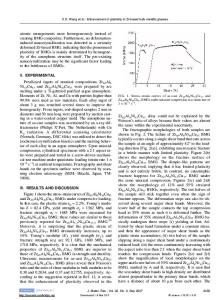Designing Zr-Cu-Co-Al Bulk Metallic Glasses with Phase Separation Mediated Plasticity
- PDF / 704,465 Bytes
- 6 Pages / 593.972 x 792 pts Page_size
- 13 Downloads / 317 Views
I.
INTRODUCTION
THE plastic deformation of bulk metallic glasses (BMGs) is localized strongly and occurs through the formation and propagation of shear bands in contrast to dislocation motion in conventional crystalline materials caused by the absence of atomic periodicity, typically resulting in limited plastic strain at room temperature.[1,2] Limited plastic flow and the lack of work hardening make BMGs prone to catastrophic failure and restrict their widespread application.[3] Because of this, extensive efforts have been made over recent years to solve the problem of low plasticity. As an effective way to improve the plastic strain, several types of BMG composites have been suggested with different lengthscale heterogeneities such as atomic-scale modulation, nanometer-scale precipitates, and micrometer-scale soft/ hard second phases.[4–12] These structurally and/or chemically inhomogeneous microstructures seem to favor the nucleation and multiplication of shear bands and impede their propagation, leading to enhanced macroscopic plasticity.[13–17] Apart from BMG composites, intrinsically plastic BMGs have been developed through careful selection of compositions and tuning the elastic constants such as to lower the shear modulus-
JIN MAN PARK, Guest Scientist, and NORBERT MATTERN, Head of Department, are with the Institute for Complex Materials, IFW Dresden, 01171 Dresden, Germany. Contact e-mail: jinman_park@ hotmail.com JUN HEE HAN, PhD Student, and JURGEN ECKERT, Direct and Professor, are with the Institute for Complex Materials, IFW Dresden, and with the Institute of Materials Science, TU Dresden, 01062 Dresden, Germany. DO HYANG KIM, Professor, is with the Department of Metallurgical Engineering, Center for Non-Crystalline Materials, Yonsei University, Seoul 120-749, Republic of Korea. Manuscript submitted April 28, 2011. Article published online January 10, 2012 2598—VOLUME 43A, AUGUST 2012
to-bulk modulus ratio or, in turn, to increase the Poisson’s ratio of the alloys.[18–20] On the other hand, because phase-separated glasses/ glass composites obtained through liquid phase separation have been reported in the La-Zr-Al-Ni-Cu system,[21,22] a variety of two-phase MGs has been found in the Ti-Y-Co-Al,[23] Ni-Nb-Y,[24] Nd-Zr-Al-Co,[25] Zr-Cu-Ni-Al,[26] and Gd-Hf-Co-Al[27] systems by the appropriate choice of composition and careful control of the cooling rate caused by the strong positive enthalpy of mixing between the constituent elements of these glass-forming alloys. More recently, two-phase glass composites were developed through a warm processing route, i.e., through consolidation of a mixture of two kinds of milled glassy powders using the viscous flow in the temperature range of their overlapping supercooled liquid regions.[28] However, the overall mechanical response of two-phase BMGs has been not understood fully and verified, yet. In this study, we selected two glass-forming alloys, i.e., Zr45Cu50Al5[29] and Zr55Co25Al20 BMGs,[30] and mixed two glassy alloys at a certain concentration ratio to obtain pha
Data Loading...











